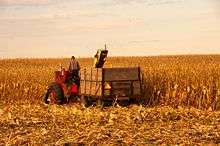Banana production in the United States
Banana production in the United States is very limited in scale and economic impact. While Americans eat 26 pounds (12 kg) of bananas per person per year, the vast majority of the fruit is imported from other countries, chiefly Central and South America.[1]
History
The first commercial banana farm in the United States was established in Florida, near Silver Lake, in 1876, but the climate wasn’t hot enough. Instead, production exploded in the Caribbean, and the Boston-based United Fruit Co.[2][3]
Current Production
Hawaii is by far the largest banana producer in the United States, followed by Florida. Banana plantation in Hawaii has followed a descending trend, from 13,181 mmt in 2000 to 8,090 mmt in 2010. Hawaii produces mainly the conventional Cavendish assortment and the Hawaiian apple banana, which are sold in the local markets due to high employment and land expenses. The chief US banana exporter is Florida, which produces mostly Thai and cooking bananas (Bluggoe type). In addition, US banana producers are looking for opportunities in the organic and specialty segments of the banana market in Florida and the beaches of Georgia.[4] Banana cultivation in Florida has been about 500 acres, valued at roughly 2 million US $.
Banana is also grown commercially in Puerto Rico,[5] Guam, and American Samoa.[6]
See Also
References
- ↑ In the USA, bananas are the fruit that is consumed ... clui.org
- ↑
- ↑ Rooted in America: Foodlore of Popular Fruits and Vegetables books.google.com
- ↑ Title:Introduction also US Banana Production edis.ifas.ufl.edu
- ↑ https://www.ars.usda.gov/ARSUserFiles/60900000/BananaIrrigation.pdf
- ↑ https://ipmdata.ipmcenters.org/documents/cropprofiles/APbananas.pdf
